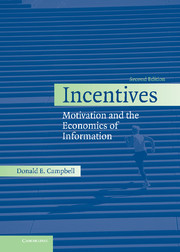Book contents
- Frontmatter
- Contents
- Preface to the Second Edition
- 1 Equilibrium, Efficiency, and Asymmetric Information
- 2 Basic Models and Tools
- 3 Hidden Action
- 4 Corporate Governance
- 5 Hidden Characteristics
- 6 Auctions
- 7 Voting and Preference Revelation
- 8 Public Goods and Preference Revelation
- 9 Matching
- 10 General Competitive Equilibrium
- References
- Author Index
- Subject Index
1 - Equilibrium, Efficiency, and Asymmetric Information
- Frontmatter
- Contents
- Preface to the Second Edition
- 1 Equilibrium, Efficiency, and Asymmetric Information
- 2 Basic Models and Tools
- 3 Hidden Action
- 4 Corporate Governance
- 5 Hidden Characteristics
- 6 Auctions
- 7 Voting and Preference Revelation
- 8 Public Goods and Preference Revelation
- 9 Matching
- 10 General Competitive Equilibrium
- References
- Author Index
- Subject Index
Summary
A successful institution, whether large or small, must coordinate the activities of its individual members. In this book, I examine the incentives at work in a wide range of institutions, to see how—and how well—coordination is achieved by informing and motivating individual decision makers. Incentives work well when they result in a high level of individual welfare generally. This is problematic because each individual acts to maximize his or her individual payoff, regardless of the implications for the welfare of others. In other words, we examine incentives to determine the extent to which they prevent the pursuit of self-interest from being self-defeating. We look at an entire economy, as well as a single firm in that economy. Even two-person institutions receive attention: a car owner and a mechanic hired to repair the car, for instance. In all cases, a satisfactory outcome requires coordination among the participants, and coordination requires information transmission and motiv ation, as shown in Table 1.1.
The individual members of the institution cannot do their part unless they receive information telling them what their roles are. In the case of a market economy, much of the vital information is transmitted by prices. In a wide range of situations, the consumer's budget constraint and the firm's profit motive give the respective decision maker the incentive to use the information embodied in prices in a way that enhances the welfare of all households.
- Type
- Chapter
- Information
- IncentivesMotivation and the Economics of Information, pp. 1 - 70Publisher: Cambridge University PressPrint publication year: 2006

